Embakasi masterplan to boost city housing
By Wahinya Henry, January 17, 2020
The dreaded traffic jams along Mombasa road in Nairobi’s eastlands are expected to ease once a master plan to re-develop the Embakasi Standard Gauge Railway (SGR) zone comes to fruition.
The whole area occupies about 10,500 hectares and includes the SGR Syokimau station, the Inland Container Depot and adjoining areas. However, the plan specifically focuses on a core area of 1,500 hectares.
A direct road bridge link has been proposed to connect the SGR terminus with Jomo Kenyatta International Airport (JKIA) while residential areas will be disconnected from the main road network or separated by green buffer zones to enhance quality of life.
Implementation of the Embakasi Station Area Redevelopment Master Plan presents an opportunity for the zone to be transformed into a business hub and a gateway to the city of Nairobi.
The Permanent Secretary for Housing and Urban Development, Charles Hinga Mwaura says establishment of Airport City will be undertaken under the master plan.
“The Airport City in the outskirts of the main Nairobi central business district is to be established around Syokimau station inland container depot and the adjoining areas,” says Hinga.
The PS says the idea to re-develop Embakasi was informed by the strategic location of the SGR and the Syokimau railway station linkage to Mombasa port and Kenya’s neighbours.

The SGR will eventually connect Mombasa with Kampala, Kigali and Juba via Nairobi. It is part of the Northern Corridor Multi-modal trade route, linking the Great Lakes Region.
Kenya, Uganda, Rwanda and South Sudan are committed to providing high capacity and cost effective railway transport via the corridor.
While each country will develop the section within its borders, Kenya is responsible for the Mombasa-Malaba section.
“Airport city will be important as the project site accommodates the Nairobi SGR terminus,” he told a stakeholders forum at Radisson Hotel in Nairobi recently, among them his boss, Cabinet Secretary, James Macharia.
The project will take off in line with the spirit of the Nairobi Metropolitan Services Improvement Project (NaMSIP) of the Ministry of Transport, Infrastructure, Public Works, and Housing and Urban Development.
NaMSIP has been implementing the projects with support of consultants and stakeholders such World Bank.
The ministry’s Head of Commuter Railway Unit, Mucemi Gakuru told Boma they had received a lot of feedback from stakeholders whose opinions will be incorporated in the plan before its launch in March.
“The main concern is congestion on Mombasa road, so we have to create alternate roads to channel traffic out of the highway,” he said.
Another request is a connection from Syokimau SGR station to JKIA. “Our colleagues at ICD also want a proper connection to Industrial area,” Gakuru said, adding that Syokimau Resident Association had ideas they want considered.
Most of these infrastructure projects are aimed at meeting the rapidly growing demands for services and infrastructure from Kenyans and the business community in the Nairobi Metropolitan Region (NMR), says NaMSIP project coordinator, engineer Benjamin Njenga.
“These transformative projects were envisioned in the Metro 2030 strategy, which is anchored on the Vision 2030 strategy, Kenya’s long term development blue print,” says Njenga.

The projects are designed to reduce bottlenecks in transport options, modern housing, solid waste management and storm water drainage among others.
“The objective is to transform Nairobi and the four neighbouring counties of Kiambu, Kajiado, Machakos and Murang’a into a sustainable world-class African metropolis that are safe, secure and prosperous,” says Njenga.
This integration of the five counties into the NMR is a pilot phase for the growth of the other five metropolitan regions in Kenya.
As a flagship projects of the Metro 2030 strategy, NaMSIP endorses orderly urbanisation by focusing on land use planning and infrastructure development.
Railway city masterplan
In May 2012, the World Bank approved US$300 million (Sh30 billion) to fund NaMSIP, with the national government contributing US$30 million (Sh3 billion) in counterpart funding.
The main objective of the project is to improve and strengthen urban services and infrastructure in the Nairobi Metropolitan area.
NaMSIP also works closely with the Athi Water Services Board (AWSB) and Kenya Railways Corporation.
Earlier last year, the State announced plans for the construction of a US $270 million (Sh27.5 billion) mega city.
Draft plans for the “Railway City” that will see the expansion of Nairobi’s Central Business District (CBD) were released, paving way for stakeholders and interested parties to air their views before the project starts.
Dubbed the Railway City Masterplan, the 425-acre project is expected to be completed in the next 20 years in three phases. Aside from the main station area, it will also contain a residential area and business hubs.
“The Nairobi Railway City will include multi-modal transit stations, mixed-use or commercial buildings, international offices, small and medium enterprise cluster and high-tech industry buildings,” said PS Hinga
The plans describe it as a “multi-modal” hub in the CBD that will guarantee “seamless connection” among commuter rail, three Bus Rapid Transits, airport limousine city bus and non-motorised transport such as bicycles. Other facilities include residential buildings, community and government buildings, open space and plazas.